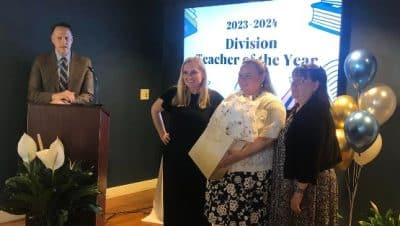
The Virginia Tech Board of Visitors got an inside look at the Institute for Critical Technology and Applied Science, a research institute that has played a supporting role in some of the university’s most celebrated initiatives.
Drone deliveries that set high-water marks for the industry, helmet ratings driving the development of safer equipment for athletes, water research that exposed critical questions about social justice and government responsibility: Those are the fruits of the institute’s mandate to pursue big ideas, in partnership with the university’s colleges and departments.
Virginia Tech’s eight research institutes are part of an infrastructure that facilitates high-impact research at the intersection of academic disciplines. ICTAS is one of four “investment institutes,” which provide critical scaffolding and support for the early stages of promising transdisciplinary collaborations.
Stefan Duma is the institute’s director.
“In a big-picture sense, what we do at ICTAS is work with departments, colleges, and individual faculty members to increase high-impact research by drawing people together into larger groups,” said Duma, the Harry Wyatt Professor of Engineering.
ICTAS works with more than 400 faculty members and 200 students across the university, strengthening collaboration with two primary levers: targeted seed investments and shared facilities.
The institute’s investments are guided by Virginia Tech’s Beyond Boundaries Initiative, which has generated a research ecosystem clustered around Destination Areas and Strategic Growth Areas: multidisciplinary communities of scholarship focusing on complex problems that impact the human condition. ICTAS works with seven of these, providing resources for students and faculty tackling urgent societal challenges.
For example, ICTAS helps support groups targeting wide-ranging aspects of water, from coastal erosion to combating antibiotic resistance in plumbing systems to the health of Virginia’s own watersheds.
And the institute’s Virginia Tech Mid-Atlantic Aviation Partnership is a national leader in drone integration, running two major federal programs and working with industry giants like State Farm and Wing.
ICTAS’ slate of seed-funding programs includes the Junior Faculty Awards, which support collaborations between junior and senior faculty from different disciplines, and initiatives that bolster undergraduate research.
A recent addition is the Diversity and Inclusion Research Investment Program, which builds faculty partnerships between Virginia Tech and historically black colleges and universities or other minority-serving institutions. In just two years, a $200,000 investment has yielded more than $1.8 million in sponsored research and robust relationships with 24 other institutions.
Facilities represent the other half of the institute’s strategy.
ICTAS has three buildings in Blacksburg, a presence in the National Capital Region at the Virginia Tech Research Center – Arlington, and is involved in planning or maintaining a portfolio of other facilities on campus, including the Virginia Tech Drone Park, which has been in constant demand since it opened.
All of these spaces are designed and managed with collaboration in mind.
“All of ICTAS lab space is shared — it’s not allocated to a single department or a college, but instead brings people together from across campus to work on different projects,” Duma explained.
The centerpiece of the institute’s first building was the Nanoscale Characterization and Fabrication Laboratory, which houses millions of dollars in specialized instruments that would be prohibitively expensive for a single lab.
Hundreds of Virginia Tech students and faculty take advantage of these resources every year; so do users from other universities, national labs, and companies. The facility has helped make the university a hub for nanoscience research and influenced its inclusion in a prestigious national nanotechnology network.
Kelly Hall, the institute’s headquarters, holds bustling labs shared by researchers working on related projects. The organic collaborations that germinate in these spaces are helping Virginia Tech carve out unique niches — in brain cancer, for example.
Researchers in the Department of Biomedical Engineering and Mechanics are pursuing new strategies for detecting and treating glioblastoma, a viciously aggressive and invariably lethal form of brain cancer. Working with colleagues at the Virginia-Maryland College of Veterinary Medicine, the Virginia Tech Carilion Research Institute, and Wake Forest University, they’re crafting an integrated research program with rapid feedback between basic research and clinical trials.
“Bringing together creative people with complementary expertise can exponentially accelerate progress,” Duma said. “We’ve structured our investment programs to incentivize those collaborations, and what we’ve seen is that it ultimately elevates the research landscape at the university and helps us answer those big questions.”










